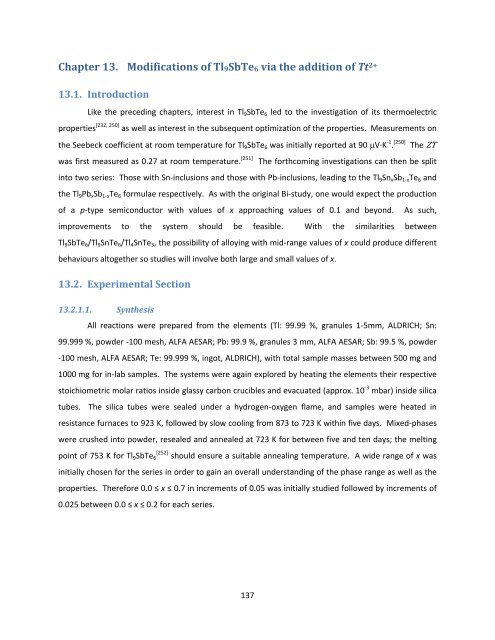Exploration and Optimization of Tellurium‐Based Thermoelectrics
Exploration and Optimization of Tellurium‐Based Thermoelectrics
Exploration and Optimization of Tellurium‐Based Thermoelectrics
You also want an ePaper? Increase the reach of your titles
YUMPU automatically turns print PDFs into web optimized ePapers that Google loves.
Chapter 13. Modifications <strong>of</strong> Tl9SbTe6 via the addition <strong>of</strong> Tt 2+<br />
13.1. Introduction<br />
Like the preceding chapters, interest in Tl9SbTe6 led to the investigation <strong>of</strong> its thermoelectric<br />
properties [232, 250] as well as interest in the subsequent optimization <strong>of</strong> the properties. Measurements on<br />
the Seebeck coefficient at room temperature for Tl9SbTe6 was initially reported at 90 V∙K ‐1 . [250] The ZT<br />
was first measured as 0.27 at room temperature. [251] The forthcoming investigations can then be split<br />
into two series: Those with Sn‐inclusions <strong>and</strong> those with Pb‐inclusions, leading to the Tl9SnxSb1‐xTe6 <strong>and</strong><br />
the Tl9PbxSb1‐xTe6 formulae respectively. As with the original Bi‐study, one would expect the production<br />
<strong>of</strong> a p‐type semiconductor with values <strong>of</strong> x approaching values <strong>of</strong> 0.1 <strong>and</strong> beyond. As such,<br />
improvements to the system should be feasible. With the similarities between<br />
Tl9SbTe6/Tl9SnTe6/Tl4SnTe3, the possibility <strong>of</strong> alloying with mid‐range values <strong>of</strong> x could produce different<br />
behaviours altogether so studies will involve both large <strong>and</strong> small values <strong>of</strong> x.<br />
13.2. Experimental Section<br />
13.2.1.1. Synthesis<br />
All reactions were prepared from the elements (Tl: 99.99 %, granules 1‐5mm, ALDRICH; Sn:<br />
99.999 %, powder ‐100 mesh, ALFA AESAR; Pb: 99.9 %, granules 3 mm, ALFA AESAR; Sb: 99.5 %, powder<br />
‐100 mesh, ALFA AESAR; Te: 99.999 %, ingot, ALDRICH), with total sample masses between 500 mg <strong>and</strong><br />
1000 mg for in‐lab samples. The systems were again explored by heating the elements their respective<br />
stoichiometric molar ratios inside glassy carbon crucibles <strong>and</strong> evacuated (approx. 10 ‐3 mbar) inside silica<br />
tubes. The silica tubes were sealed under a hydrogen‐oxygen flame, <strong>and</strong> samples were heated in<br />
resistance furnaces to 923 K, followed by slow cooling from 873 to 723 K within five days. Mixed‐phases<br />
were crushed into powder, resealed <strong>and</strong> annealed at 723 K for between five <strong>and</strong> ten days; the melting<br />
point <strong>of</strong> 753 K for Tl9SbTe6 [252] should ensure a suitable annealing temperature. A wide range <strong>of</strong> x was<br />
initially chosen for the series in order to gain an overall underst<strong>and</strong>ing <strong>of</strong> the phase range as well as the<br />
properties. Therefore 0.0 ≤ x ≤ 0.7 in increments <strong>of</strong> 0.05 was initially studied followed by increments <strong>of</strong><br />
0.025 between 0.0 ≤ x ≤ 0.2 for each series.<br />
137
















